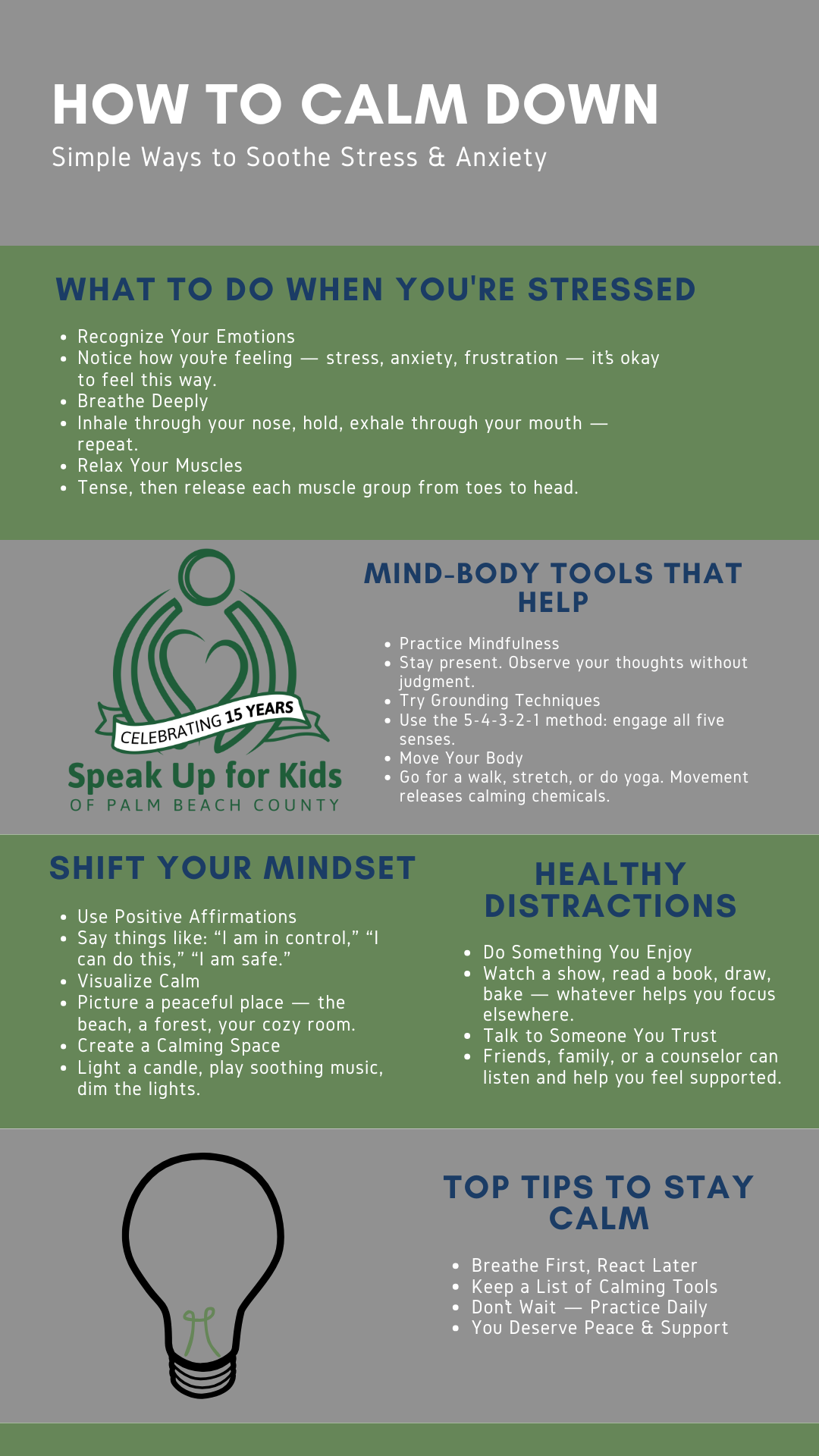How to Calm Down
Contributed by Speak Up for Kids Student Intern Team — This article was developed through the combined efforts of multiple student interns, each bringing unique skills and perspectives to support life skills education for foster youth.
Overview
Stress and anxiety are natural parts of life, but they don’t have to control how you feel or act. By learning simple, effective techniques, you can calm your body, clear your mind, and regain a sense of balance. Whether you’re dealing with a stressful moment or building long-term coping skills, the following steps can help you manage your emotions in a healthy way.
Steps:
Recognize Your Emotions:
Acknowledge that you are feeling stressed, anxious, or upset.
Understand that these feelings are normal and temporary.
Deep Breathing:
Take a deep breath in through your nose, hold it for a few seconds, and then slowly exhale through your mouth.
Repeat this process several times. Deep breathing helps lower your heart rate and reduces stress.
Progressive Muscle Relaxation:
Start by tensing and then slowly relaxing each muscle group in your body, beginning with your toes and working your way up to your head.
This technique helps release physical tension and promotes relaxation.
Practice Mindfulness:
Focus on the present moment. Pay attention to your breath, bodily sensations, or the environment around you.
Use mindfulness techniques, such as guided meditation or simply observing your thoughts without judgment.
Grounding Techniques:
Use grounding techniques to bring yourself back to the present. For example, name five things you can see, four things you can touch, three things you can hear, two things you can smell, and one thing you can taste.
This can help distract your mind from stress and anxiety.
Engage in Physical Activity:
Go for a walk, do some yoga, or engage in any physical activity you enjoy.
Exercise helps release endorphins, which are natural mood lifters.
Use Positive Affirmations:
Repeat calming and reassuring phrases to yourself, such as “I am in control,” “I can handle this,” or “I am calm and relaxed.”
Positive affirmations can help shift your mindset and reduce anxiety.
Create a Calming Environment:
Find a quiet, comfortable place where you can relax.
Use calming scents, such as lavender or chamomile, and play soft, soothing music if it helps.
Distract Yourself:
Engage in an activity you enjoy, such as reading, watching a favorite show, or doing a hobby.
Distraction can help take your mind off what is causing you stress.
Talk to Someone:
Reach out to a friend, family member, or therapist to talk about what’s bothering you.
Sharing your feelings can provide relief and offer a new perspective.
Use Visualization:
Close your eyes and imagine a peaceful place or situation. Visualize every detail of this place, from the sights and sounds to the smells and feelings.
Visualization can help transport your mind away from stress and into a state of calm.
Practice Self-Care:
Take care of your physical and emotional needs. Get enough sleep, eat a healthy diet, and stay hydrated.
Self-care activities, such as taking a warm bath, journaling, or practicing a hobby, can help you relax and unwind.
Tips:
Stay Consistent: Make relaxation techniques a regular part of your routine to help manage stress over time.
Identify Triggers: Be aware of what triggers your stress or anxiety and try to address these issues proactively.
Seek Professional Help: If you find it difficult to calm down or manage stress on your own, consider seeking help from a mental health professional.
Final Thoughts
Managing stress is an ongoing process, and the more consistently you practice these techniques, the more natural they will become. By staying aware of your emotions, using calming strategies, and taking care of your overall well-being, you can create a strong foundation for handling life’s challenges. Remember—every small step you take toward calmness strengthens your resilience.


